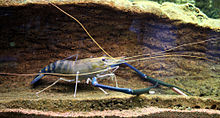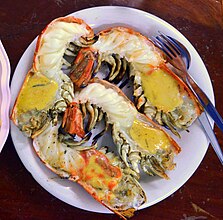| Macrobrachium rosenbergii | |
|---|---|

| |
| Conservation status | |
 Least Concern (IUCN 3.1) | |
| Scientific classification | |
| Domain: | Eukaryota |
| Kingdom: | Animalia |
| Phylum: | Arthropoda |
| Class: | Malacostraca |
| Order: | Decapoda |
| Suborder: | Pleocyemata |
| Infraorder: | Caridea |
| Family: | Palaemonidae |
| Genus: | Macrobrachium |
| Species: | M. rosenbergii |
| Binomial name | |
| Macrobrachium rosenbergii De Man, 1879 | |

Macrobrachium rosenbergii, also known as the giant river prawn or giant freshwater prawn, is a commercially important species of palaemonid freshwater prawn. It is found throughout the tropical and subtropical areas of the Indo-Pacific region, from India to Southeast Asia and Northern Australia. The giant freshwater prawn has also been introduced to parts of Africa, Thailand, China, Japan, New Zealand, the Americas, and the Caribbean. It is one of the biggest freshwater prawns in the world, and is widely cultivated in several countries for food. While M. rosenbergii is considered a freshwater species, the larval stage of the animal depends on estuarine brackish water. Once the individual shrimp has grown beyond the planktonic stage and becomes a juvenile, it migrants from the estuary and lives entirely in fresh water.
It is also known as the Malaysian prawn, freshwater scampi (India), or cherabin (Australia). Locally, it is known as golda chingri (Bengali: গলদা চিংড়ি) in Bangladesh and India, udang galah in Indonesia and Malaysia, uwáng or uláng in the Philippines, Thailand prawn in Southern China and Taiwan (Chinese: Tàiguó xiā 泰國蝦), and koong mae nam (กุ้งแม่น้ำ) or koong ghram gram (กุ้งก้ามกราม) in Thailand.
Description

M. rosenbergii can grow to a length over 30 cm (12 in). They are predominantly brownish in colour, but can vary. Smaller individuals may be greenish and display faint vertical stripes. The rostrum is very prominent and contains 11 to 14 dorsal teeth and 8 to 11 ventral teeth. The first pair of walking legs (pereiopods) is elongated and very thin, ending in delicate claws (chelipeds), which are used as feeding appendages. The second pair of walking legs are much larger and powerful, especially in males. The movable claws of the second pair of walking legs are distinctively covered in dense bristles (setae) that give them a velvety appearance. The colour of the claws in males varies according to their social dominance.
Females can be distinguished from males by their wider abdomens and smaller second pereiopods. The genital openings are found on the body segments containing the fifth pereiopods and the third pereiopods in males and females, respectively.
This sexual dimorphism is driven by the IAG physiological sexual switch, discovered by Prof. Amir Sagi and his research group, and monosex biotechnologies were established for all-male and all-female culture. The all-male technology includes the first application of temporal RNA interference (RNAi) in the field of aquaculture. Also, all-female culture technology was established. Crustacean monosex technologies are applied in Vietnam, Thailand, China, Malaysia and Israel.
Morphotypes
Three different morphotypes of males exist. The first stage is called "small male" (SM); this smallest stage has short, nearly translucent claws. If conditions allow, small males grow and metamorphose into "orange claws" (OC), which have large orange claws on their second chelipeds, which may have a length of 0.8 to 1.4 times their body size. OC males later may transform into the third and final stage, the "blue claw" (BC) males. These have blue claws, and their second chelipeds may become twice as long as their bodies.
Males of M. rosenbergii have a strict hierarchy; the territorial BC males dominate the OCs, which in turn dominate the SMs. The presence of BC males inhibits the growth of SMs and delays the metamorphosis of OCs into BCs; an OC keeps growing until it is larger than the largest BC male in its neighbourhood before transforming. All three male stages are sexually active, and females that have undergone their premating moult cooperate with any male to reproduce. BC males protect the females until their shells have hardened; OCs and SMs show no such behaviour.
Life cycle
In mating, the male deposits spermatophores on the underside of the female's thorax, between the walking legs. The female then extrudes eggs, which pass through the spermatophores. The female carries the fertilised eggs with her until they hatch; the time may vary, but is generally less than 3 weeks. Females lay 10,000–50,000 eggs up to five times per year.
From these eggs hatch zoeae, the first larval stage of crustaceans. They go through several larval stages in brackish water before metamorphosing into postlarvae, at which stage they are 0.28–0.39 in (7.1–9.9 mm) long and resemble adults. This metamorphosis usually takes place about 32 to 35 days after hatching. These postlarvae then migrate back into fresh water.
References
- De Grave, S.; Shy, J.; Wowor, D.; Page, T. (2013). "Macrobrachium rosenbergii". IUCN Red List of Threatened Species. 2013: e.T197873A2503520. doi:10.2305/IUCN.UK.2013-1.RLTS.T197873A2503520.en. Retrieved 19 November 2021.
- "Fisheries and Aquaculture - Global Production". Food and Agriculture Organization of the United Nations (FAO). Retrieved 6 May 2024.
- ^ H. Motoh & K. Kuronuma (1980). Field guide for the edible crustacea of the Philippines. Southeast Asian Fisheries Development Center (SEAFDEC). p. 44. Archived from the original on 1 December 2017. Retrieved 23 December 2016.
- ^ "Macrobrachium rosenbergii (giant freshwater prawn)". CABI. Archived from the original on 23 December 2016. Retrieved 23 December 2016.
- ^ Forrest Wynne (May 2000). "Grow-out culture of freshwater prawns in Kentucky". Archived from the original on 21 August 2008. Retrieved 4 July 2005.
- "(In Chinese) 大陸南方養蝦發展動態概述". www.miobuffer.com.tw. Retrieved 6 January 2024.
- T. Y. Chan (1998). "Shrimps and Prawns". In Kent E. Carpenter; Volker H. Niem (eds.). The Living Marine Resources of the Western Central Pacific. Volume 2: Cephalopods, Crustaceans, Holothurians and Sharks (PDF). FAO Species Identification Guide for Fishery Purposes. Food and Agriculture Organization. ISBN 92-5-104051-6.
- Levy and Sagi, Tom and Amir (10 September 2020). "The "IAG-Switch"—A Key Controlling Element in Decapod Crustacean Sex Differentiation". Frontiers in Endocrinology. 11.
- Ventura and Sagi, Tomer and Amir (25 April 2012). "The insulin-like androgenic gland hormone in crustaceans: From a single gene silencing to a wide array of sexual manipulation-based biotechnologies". Biotechnology Advances. 30 (6): 1543–1550.
- Kenji, Toyota (15 September 2024). "Crustacean endocrinology: Sexual differentiation and potential application for aquaculture". General and Comparative Endocrinology. 356: 114578 – via Elsevier Science Direct.
- "About us". Enzootic.
- Putsucha, Phansawat; et al. (January–April 2022). "Benefits of Male Monosex Culture of Giant Freshwater Prawn (Macrobrachium rosenbergii): Improving Growth Performance, Production Yield, and Profitability". Journal Of Fisheries And Environment. 46 (1). Kasetsart University: 157–168. ISSN 2630-0702.
- ^ A. Barki; I. Karplus & M. Goren (1991). "Morphotype related dominance hierarchies in males of Macrobrachium rosenbergii (Crustacea, Palaemonidae)". Behaviour. 117 (3/4): 145–160. doi:10.1163/156853991x00508. JSTOR 4534936.
External links
- How to Know Gender of Macrobrachium rosenbergii.
- Macrobrachium rosenbergii diet.
- Prove Macrobrachium rosenbergii can upsize in wild.
- How to catch Macrobrachium rosenbergii.
- FAO Fisheries & Aquaculture: Macrobrachium rosenbergii - 2021
- Aquaculture of Texas
 Media related to Macrobrachium rosenbergii at Wikimedia Commons
Media related to Macrobrachium rosenbergii at Wikimedia Commons
| Taxon identifiers | |
|---|---|
| Macrobrachium rosenbergii |
|